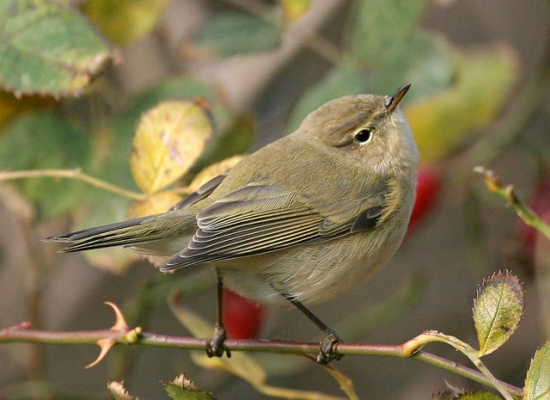(Imp sizes. Additional recording. References updated) |
|||
| Line 4: | Line 4: | ||
'''Includes: Siberian Chiffchaff''' | '''Includes: Siberian Chiffchaff''' | ||
==Identification== | ==Identification== | ||
| − | 10-12 cm<br /> | + | 10-12 cm (4-4¾ in)<br /> |
*Greenish olive-brown upperparts | *Greenish olive-brown upperparts | ||
*Off-white underpart | *Off-white underpart | ||
*Yellowish flanks | *Yellowish flanks | ||
| − | *Short white supercilium | + | *Short white [[Topography#Heads|supercilium]] |
*Fine dark bill and legs | *Fine dark bill and legs | ||
[[Image:WillowChiff.jpg|thumb|350px|right|Chiffchaff on the left and Willow Warbler on the right<br /> Photo by {{user|Steve+G|Steve G}}]] | [[Image:WillowChiff.jpg|thumb|350px|right|Chiffchaff on the left and Willow Warbler on the right<br /> Photo by {{user|Steve+G|Steve G}}]] | ||
| Line 49: | Line 49: | ||
<flashmp3>Phylloscopus collybita (song).mp3</flashmp3><br /> | <flashmp3>Phylloscopus collybita (song).mp3</flashmp3><br /> | ||
''[[Media:Phylloscopus collybita (song).mp3|Listen in an external program]]'' | ''[[Media:Phylloscopus collybita (song).mp3|Listen in an external program]]'' | ||
| − | + | <br /> | |
| + | <br /> | ||
| + | <flashmp3>Chiffchaff Nigg Bay 191116aMP3.mp3</flashmp3><br /> | ||
| + | ''[[Media:Chiffchaff Nigg Bay 191116aMP3.mp3|Listen in an external program]]'' | ||
| + | It sounds at first like a ''tristis'' but is much too downslurred and not flat enough. <br /> | ||
| + | Recording by {{user|Andrew+Whitehouse|Andrew Whitehouse}}<br /> | ||
| + | Nigg Bay, Aberdeen, [[Scotland]], November 2016<br /> | ||
| + | [http://www.birdforum.net/showthread.php?p=3485696#post3485696 More information about this recording can be found in this post] | ||
==References== | ==References== | ||
| − | #{{Ref- | + | #{{Ref-Clements6thAug16}}#[http://www.birdforum.net/showthread.php?t=241006 Birdforum thread] discussing finer points of identification between Chiffchaff and Willow Warbler |
#Collins Pocket Guide to British Birds 1966 | #Collins Pocket Guide to British Birds 1966 | ||
#Collins Field Guide 5th Edition | #Collins Field Guide 5th Edition | ||
Revision as of 00:40, 20 November 2016
Alternative name: Eurasian Chiffchaff
- Phylloscopus collybita
Includes: Siberian Chiffchaff
Identification
10-12 cm (4-4¾ in)
- Greenish olive-brown upperparts
- Off-white underpart
- Yellowish flanks
- Short white supercilium
- Fine dark bill and legs
Confusion Species
See this discussion thread for differences between Chiffchaff and Willow Warbler.
Distribution
Breeds thoughout much of Europe and Asia, wintering in south and west Europe, southern Asia and northern Africa.
Very patchy distribution in Scotland.
Taxonomy
Subspecies
Six subspecies are recognized:[1]
- P. c. abietinus:
- Scandinavia to Urals, Caucasus, Transcaucasia and northern Iran
- P. c. collybita:
- P. c. brevirostris:
- Highlands of western Turkey and Black Sea coastlands of northern Turkey
- P. c. caucasicus:
- East of range of brevirostris at lower elevations south to Armenia
- P. c. menzbieri:
- P. c. tristis:
Tristis is sometimes accepted as full species, called Siberian Chiffchaff.
The Canary Islands Chiffchaff and the Iberian Chiffchaff have been considered conspecific with this species.
Habitat
Open woodlands, tall trees are required for singing in the breeding season. Low shrubs, brambles etc for nesting.
Behaviour
Flicks tail, downwards (this habit is not seen in Willow Warbler).
Breeding
The female builds a domed nest with a side entrance, made from dead leaves and grass. Two to seven cream eggs with reddish-purple or blackish spots, are laid and incubated by the female for 13–14 days; the female cares for the young for about two weeks until they fledge.
Diet
The diet includes insects.
Vocalisation
Song: the most reliable way to distinguish from Willow Warbler. It sings its name chiff chaff, chiff chaff, though sometimes mixes up to chiff chiff, chaff, chaff.
Call: a soft wheett
<flashmp3>Phylloscopus collybita (song).mp3</flashmp3>
Listen in an external program
<flashmp3>Chiffchaff Nigg Bay 191116aMP3.mp3</flashmp3>
Listen in an external program
It sounds at first like a tristis but is much too downslurred and not flat enough.
Recording by Andrew Whitehouse
Nigg Bay, Aberdeen, Scotland, November 2016
More information about this recording can be found in this post
References
- Clements, J. F., T. S. Schulenberg, M. J. Iliff, D. Roberson, T. A. Fredericks, B. L. Sullivan, and C. L. Wood. 2016. The eBird/Clements checklist of birds of the world: v2016, with updates to August 2016. Downloaded from http://www.birds.cornell.edu/clementschecklist/download/
- Birdforum thread discussing finer points of identification between Chiffchaff and Willow Warbler
- Collins Pocket Guide to British Birds 1966
- Collins Field Guide 5th Edition
- Collins Bird Guide ISBN 0 00 219728 6
- Wikipedia
Recommended Citation
- BirdForum Opus contributors. (2024) Common Chiffchaff. In: BirdForum, the forum for wild birds and birding. Retrieved 20 April 2024 from https://www.birdforum.net/opus/Common_Chiffchaff
External Links






